
Ever since the first contact with explorers and whalers,
Inuit were eager to acquire steel products from which they fashioned tools that
were adapted to their own specific needs. It was only a small step for Inuit to
use their talents in fashioning tools for hunting and daily life to creating
sculptures for the world art market. The objects shown here were included in the
exhibition to provide a cultural context for these artworks.

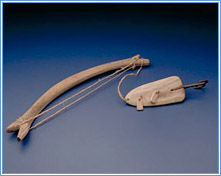 Fishing through the ice was a springtime activity. The sinker, which weighted the line and the hook, has pieces of antler attached to it. These acted as lures and moved as the line was jiggled up and down. Fishing through the ice was a springtime activity. The sinker, which weighted the line and the hook, has pieces of antler attached to it. These acted as lures and moved as the line was jiggled up and down.
Aulasaut (fishing rod, line and sinker), 1967
Coppermine River
Antler, plaited sinew and copper
Canadian Museum of Civilization
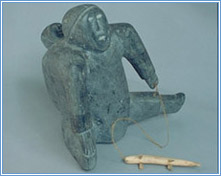
It appears that Uyauperq was quite unaware of the beauty and power of her work.
She tended to be very shy about it. She preferred to work out of doors but if anyone
came to look, she would quickly wrap up the stone in a piece of canvas and run inside.
"When I began carving I used to think of my children, how they were going
to get food and clothing,..but I do not carve only for money..I want my children to
be proud of me, of what I did, and I want them to be happy about the carvings."
(personal communication with Ingo Hessel)
Woman Fishing, 1967
Margaret Uyauperq Aniksak (1905-1993)
Arviat
Stone, antler, sinew
Collection of James Houston

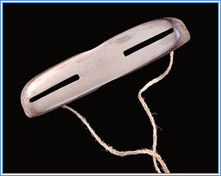 "Snow blindness, a dangerous and extremely painful condition, is caused by the reflection of strong spring light off the snow. The narrow slits in the goggles provide excellent protection. Gunpowder or soot mixed with oil and rubbed on the outside cuts down the glare even more." (Things Made by Inuit, Fédération des coopératives du Nouveau-Québec) "Snow blindness, a dangerous and extremely painful condition, is caused by the reflection of strong spring light off the snow. The narrow slits in the goggles provide excellent protection. Gunpowder or soot mixed with oil and rubbed on the outside cuts down the glare even more." (Things Made by Inuit, Fédération des coopératives du Nouveau-Québec)
Iggaak (snow goggles), 1975
Gjoa Haven
Antler and sinew
Canadian Museum of Civilization
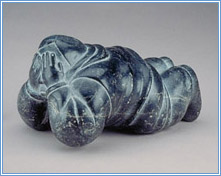
The sculpture has been carved all around, as if it was meant to be picked up.
It shows the experience of Atungak, the world traveller, who has been blinded by
the Arctic sun reflected on the snow in the spring. Before sunglasses, hunters
used to wear snow goggles made out of antler with only two slits to see through.
Atungak, the World Traveller, Snow-blind, 1956
Juanisialu Irqumia (1912-1977)
Povungnituk
Stone
Canadian Museum of Civilization
Gift of the Department of Indian Affairs and Northern Development, 1989

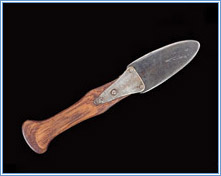 "In traditional times knives were fashioned from flint or other hard, durable stone. Now steel knives are used everywhere and are much preferred. The knife, killuutiviniq, was typically employed in skinning game, and one important use was in skinning the square flipper seal spirally in long strips. These strips, about an inch in width, were made up into harnesses and traces for the dog teams." (The Inuit World, Kingait Press) "In traditional times knives were fashioned from flint or other hard, durable stone. Now steel knives are used everywhere and are much preferred. The knife, killuutiviniq, was typically employed in skinning game, and one important use was in skinning the square flipper seal spirally in long strips. These strips, about an inch in width, were made up into harnesses and traces for the dog teams." (The Inuit World, Kingait Press)
Killuutiviniq ("made from a saw"), 1922
Igloolik
Wood, steel and metal
Canadian Museum of Civilization
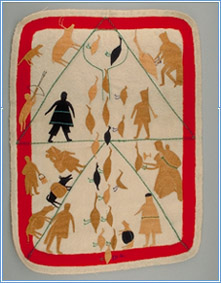
Jessie Oonark did a little drawing and some appliqué sewing while living in caribou country, but she began her most important work after she moved to Baker Lake. A teacher there introduced James Houston to Oonark in 1955, when he was on the government's Central Arctic Patrol, and he first saw some of her inspired sewing designs.
Driving Flightless Geese into Stone Pens, 1965
Jessie Oonark (1906-1985)
Baker Lake
white duffle, red stroud, skin and floss
Collection of James Houston

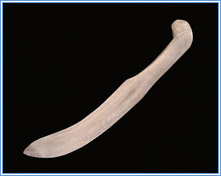 The snow knife was one of the hunter's most important tools. It was used to cut blocks of snow when building igloos. The snow knife was one of the hunter's most important tools. It was used to cut blocks of snow when building igloos.
Pana (snow knife), 1907-1909
Chesterfield Inlet
Antler
Canadian Museum of Civilization
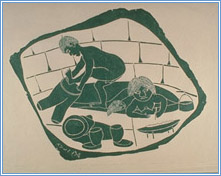
The image provides an intimate glimpse into the interior of an igloo. While the man
is getting into his clothes the woman tends to the seal oil lamp to ensure warmth.
This is similar to us stoking the fire in the stove in the morning. The child is
still sleeping.
Wakening Up, 1966
Paulosie Sivuak (1930-1986)
Povungnituk
stonecut C/30
Gift of the Fédération des Coopératives du Nouveau-Québec
Canadian Museum of Civilization

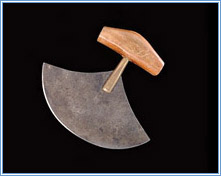 "The ulu . . . is a crescent-shaped knife which is used with either a slicing or a rocking motion, and is the primary tool employed by a woman in cutting out clothing, boots and mittens. It is used for preparing skins . . . for expressing oil, and it serves as a culinary implement. This general purpose cutting tool, which continues to persist in daily use, has become the chief symbol associated with Inuit women." (The Inuit World, Kingait Press) "The ulu . . . is a crescent-shaped knife which is used with either a slicing or a rocking motion, and is the primary tool employed by a woman in cutting out clothing, boots and mittens. It is used for preparing skins . . . for expressing oil, and it serves as a culinary implement. This general purpose cutting tool, which continues to persist in daily use, has become the chief symbol associated with Inuit women." (The Inuit World, Kingait Press)
Ulu (woman's knife), 1972
Rankin Inlet
Wood, copper and metal
Canadian Museum of Civilization
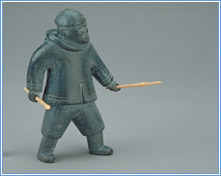
This work was acquired with the assistance of a grant from the Government of Canada under the terms of the Cultural Property Export and Import Act.
This is one of the few documented self-portraits in Inuit art. We do not know how the collector found out that this piece, together with Munamee's Wife and Baby (CMC IV-C-4966), were portraits of Munamee and his wife and child. It may have been in connection with a work by Munnamee that was given to Queen Elizabeth in November 1951.
Self-Portrait as a Hunter, c. 1951
Munamee Shaqu (1917- )
Cape Dorset
Stone and ivory
Canadian Museum of Civilization
Iqqaipaa Menu
|